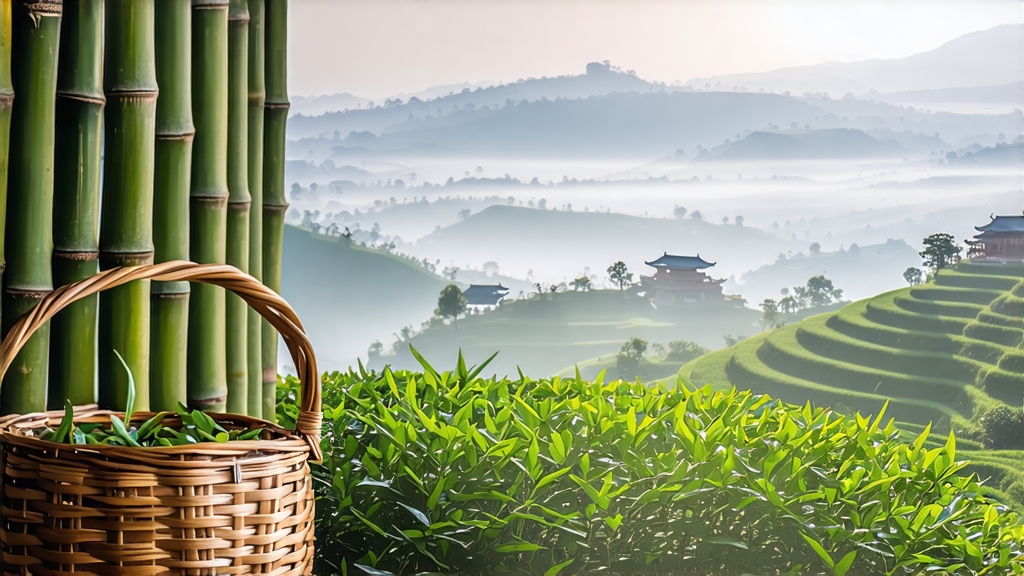
If green tea is the fresh-faced youth of Chinese tea and pu-erh the venerable elder, then yellow tea occupies the quiet, cultivated middle ground—rare, refined, and once reserved for emperors. Among the handful of authentic yellow teas still crafted today, Meng Ding Huang Ya from the mist-capped peaks of Ya’an, Sichuan, is the most storied. International drinkers who encounter it for the first time often describe the experience as “finding a chamomile that grew up in an orchid greenhouse,” a poetic hint at both its soothing texture and lingering floral complexity. Yet behind the cup lies fifteen centuries of monastic stewardship, a labor-intensive micro-fermentation called “sealed yellowing,” and a leaf so tender that it must be harvested before the Qingming festival, when each bud is still shorter than a knuckle.
Historical tapestry
Meng Ding (“Mount Meng”) rises abruptly from the western edge of the Sichuan basin, its summit permanently wrapped in cloud. Buddhist monks began planting tea here during the Tang dynasty (618-907 CE) after noticing that the perennial fog slowed leaf growth, concentrating amino acids and sweetness. By the Song dynasty the imperial court had claimed the mountain’s earliest buds as tribute; Song Huizong himself is said to have written calligraphy praising the tea’s “golden dew” liquor. When Ming tea masters discovered that a light, humid oxidation could soften the grassy edge typical of Sichuan greens, Meng Ding Huang Ya was born. Production peaked in the early 1700s, then faded as black and oolong teas dominated export markets. Only a few family workshops kept the art alive, making today’s batches—fewer than three tons a year—among the scarcest of China’s historic teas.
Micro-terroir
The garden zone sits between 800 m and 1,400 m on steep sandstone slopes. Nights are cool, days are bright but filtered by cloud, and annual rainfall exceeds 1,800 mm. The soil is acidic, rich in iron and organic leaf litter from evergreen forests. Critically, the mountain’s endemic bamboo and wild orchids host a yeast population that colonizes withered leaves, contributing the tea’s signature orchid-bamboo aroma. Because the area is now a protected UNESCO mixed heritage site, no agro-chemicals are permitted; instead, farmers plant aromatic citronella grass between rows to deter insects.
Leaf standard
Authentic Meng Ding Huang Ya is picked in a ten-day window around late March. Only the unopened bud plus the first unfolding leaf (called “sparrow’s tongue”) are taken. The ideal length is 1.5–2 cm; larger material is diverted to cheaper green teas. Pickers wear cotton gloves to avoid bruising the surface trichomes that later give the liquor its downy shimmer.
Craft: the five breaths of yellowing
- Pan-killgreen (shaqing): 220 °C for 90 seconds in a cast-iron wok. The goal is to halt oxidative enzymes while keeping 10 % residual activity—higher than for green tea—so that later yellowing can proceed.
- Initial rolling: Light pressure for four minutes; only 20 % cell rupture is desired, enough to release sap for bonding but not so much that the leaf darkens.
- First wrap (menhuang): The hot leaves are immediately piled in small bamboo baskets lined with wet cotton. The core temperature is allowed to climb to 38 °C over two hours; this “breath” develops the precursor compounds responsible for honey aroma.
- Second firing: Wok temperature is lowered to 100 °C; leaves are tossed for just 30 seconds to drive off surface moisture and re-activate enzymes.
- Second wrap: The pile is covered with steamed wild orchid leaves that inoculate the tea with local microflora. Over four hours the leaf edges turn pale primrose, while the veins remain jade green—the hallmark two-tone appearance.
- Low-temperature drying: Charcoal embers at 60 °C slowly reduce moisture to 5 % across six hours. Masters listen for a brittle “click” that signals the tea is ready; too dry and the yellowing aromatics volatilize, too moist and the tea will sour in storage.
Grading
Imperial grade: 100 % buds, liquor the color of chardonnay, downy suspension visible in the cup.
Superfine: One bud to one leaf ratio, brighter yellow infusion, orchid forward.
First grade: One bud to two leaves,